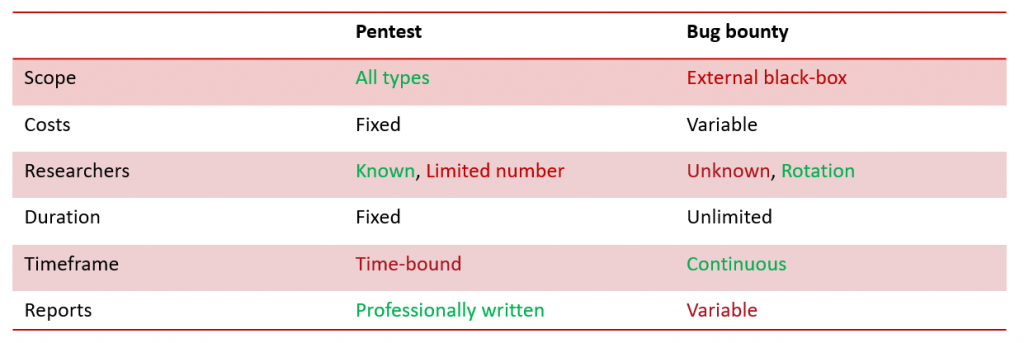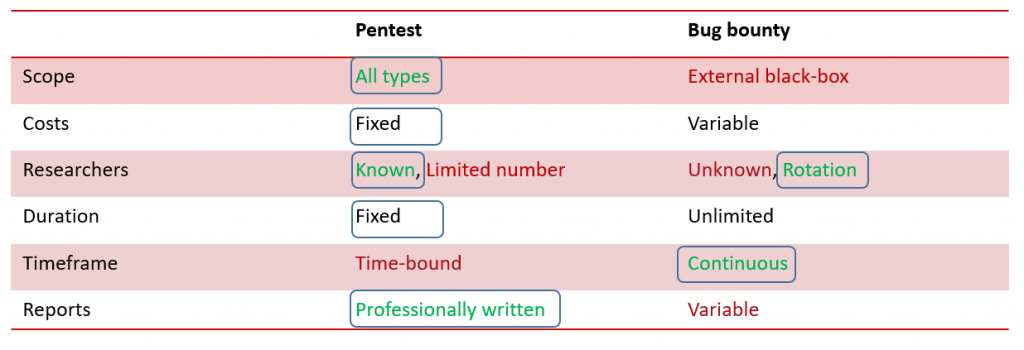At SCRT, we have been performing penetration tests for nearly 20 years now and have always tried to improve our methodologies to match client expectations and deliver the most accurate and useful results from each test we undertake.
Over the last few years, Bug bounty programs have been making a name for themselves as they bring a new approach to assessing the security level of a company, application or system. They allow for a more continuous, albeit less controlled, testing of a targeted scope.
Some people will probably argue that bug bounties and pentests are antagonistic, while I believe that they are two very complementary approaches for achieving a better overall security level. Mature companies tend to move towards a system where penetration tests are performed to discover vulnerabilities and essentially verify the security level of an application or system when it is deployed or updated, and a bug bounty program is then used to ensure a sort of continuous monitoring from a larger population of bug hunters.

There are advantages and drawbacks to both pentesting and bug bounties, which is why they can be used together to achieve better results. I’ve attempted to compare both options in a rather simplified manner, while trying to emphasize where each option outperforms the other.

Obviously some people will disagree with what is considered as an advantage and what isn’t but I have tried to remain as neutral as possible and typically, when it comes to costs, the fact they are essentially unknown and entirely dependent on the number of vulnerabilities and their classification in a bug bounty program will be seen as a clear advantage for some and an inconvenient for others, which is why I’ll let you decide where you stand on that issue.
The same goes for the duration. I would tend to believe that an unlimited test would be more interesting than a limited one, but it also means that the company must be able to react to potential incidents at any time and coordinate more closely with the SOC.
We have noticed that many companies are reluctant to setting up a bug bounty program. Having helped in organising and managing the Public Intrusion Test (PIT) for the Swiss e-voting system last year (which was essentially a temporary bug bounty program), we also understand why. The main issues we ran into can be summarised as such:
- Poor quality and out of scope submissions
- Difficult to know how many people (if any) will actually look at the system
- Difficulty to establish a trust relationship with the participants as they are essentially anonymous
- Difficulty to define the bounty amounts and control costs (although this wasn’t done by us in this case)
Now I know most Bug bounty platforms will attempt to help companies in managing these issues, but we felt there was a way SCRT could also help our clients bridge the gap between traditional pentesting and bug bounties. This is where our Continuous pentesting offer comes in.
The idea is to take the advantages of both the pentesting and bug bounty worlds while minimising the drawbacks. The main advantage of this system is that whatever elements are included in the scope are assured to be tested by a rotating pool of trusted SCRT engineers at various times throughout the year.

Regarding costs, we are sticking to a more traditional pentesting approach, where we will be using a per-day rather than per-vulnerability model so as to fully control the costs of the tests beforehand.
We cannot provide a 24/7 monitoring of all vulnerabilities within a specific scope, but by avoiding pre-planned dates, it gives us the flexibility to test when new vulnerabilities or types of attacks emerge so that we can verify whether or not your systems are affected in a more dynamic and proactive way.
If you’re interested in this approach, feel free to contact us to get additional details and see how we can best adapt our offer to your requirements.
